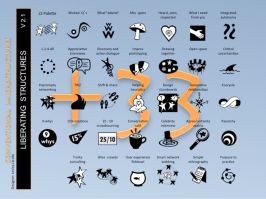Liberating structures
Liberating Structures (LS) is a web-based resource that offers three dozen processes to get people thinking and working together effectively. The processes are tools, as well as a way of thinking about working with people. They are designed to neutralize power dynamics and build trust. LS do not require lengthy training to adopt, and they can be mixed and matched for particular organizational needs. They use simple rules to encourage managers to step back and encourage employees to take leadership roles at all levels.
At the NCCDH, we use Liberating Structures (LS) for both our internal management work and our health equity engagement work with audiences across the country. These “simple, subtle [and] powerful” processes have been exceedingly well received. In fact, in our leadership for health equity research, the ability to facilitate groups with these processes was identified as a core skill.
The conventional methods people use to share or seek information—presentations, brainstorming, and discussions—are not so effective at engaging people. In the early 2000s, Henri Lipmanowicz, and Keith McCandless noted this weakness. They were convinced that the complexity science principle—which states that a small change can make a big difference—could be applied to the way people work together. In the course of their research, they found that small adjustments in the way people interact have large impacts on organizational culture and resilience, which led to their creation of the LS website and consulting work.
Three of the simplest liberating structures are
- 1-2-4-All . Silent self-reflection on a question, followed by sharing reflections in pairs and groups of four, and a full group discussion of what stood out in the conversations
- TRIZ . A process using humour to 1) identify what we do to reliably get the worst result imaginable; 2) honestly compare this list with what we do now; and 3) generate ideas about how to stop doing those things
- Impromptu networking . People have three conversations, in short rounds, in response to an important question about their work together
Use this resource to
- Add new energy and engagement to conversations that are “stuck”
- Design workshops, conferences and meetings that draw on everyone’s insights in solving problems or designing new approaches
- Build a team of employees or volunteers who feel valued and involved in the direction of the organization
Lipmanowicz, H. & McCandless, K. (n.d.) Liberating Structures.
Tags: Community engagement, Leadership & capacity building, Methods & tools, Working conditions, Website
